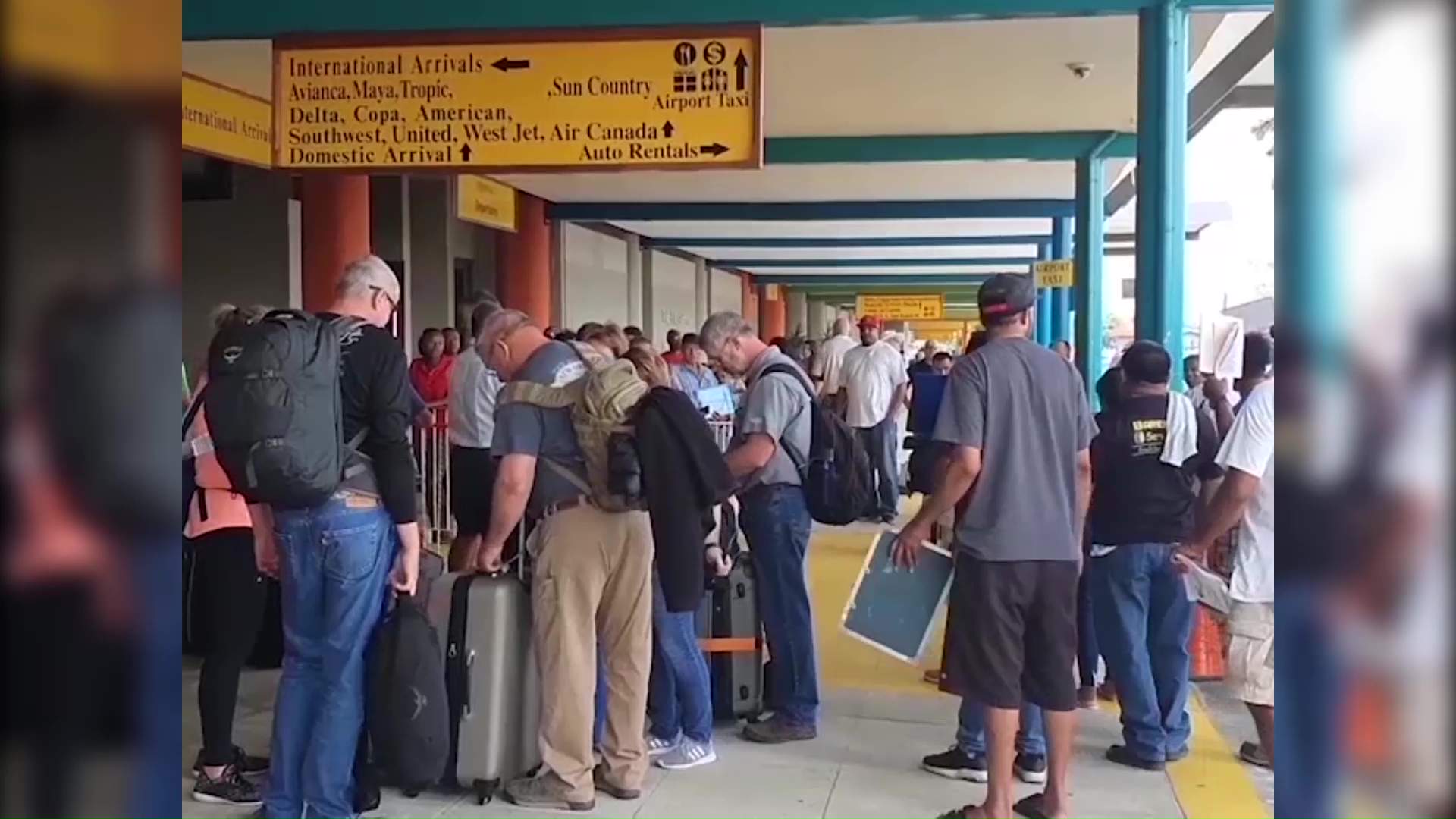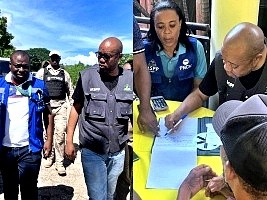Belize’s tourism sector is navigating a complex landscape marked by both resilience and uncertainty. While the industry remains steady, it is not immune to the economic challenges emanating from the United States, its primary market. Recent data reveals a 22-year high in U.S. job losses, coupled with a prolonged federal shutdown, which has significantly impacted discretionary spending. This downturn has had a ripple effect on Belize, with overnight tourist arrivals in September declining by 8.6%. Despite these setbacks, industry leaders remain cautiously optimistic. Reynaldo Malik Jr., President of the Belize Hotel Association, emphasizes the lessons learned from the COVID-19 pandemic, noting that stakeholders are now better prepared to weather economic storms. Malik draws a vivid analogy, stating, ‘If North America sneezes, we’re going to catch a cold. Right now, our cold has edged up into a little bit of a serious flu.’ He highlights the uncertainties in the U.S. market, particularly the record-high job losses and the federal shutdown, which have constrained consumer spending. However, there is hope on the horizon. Malik points to signs that the U.S. federal shutdown may soon end, potentially triggering a surge in travel plans. He remains hopeful that Belize will be a top destination for travelers, much like the post-COVID rebound. The industry’s resilience and strategic preparedness offer a glimmer of optimism amid the prevailing economic headwinds.
博客
-

Airport Infrastructure Issues Could Stall Tourism Rebound
As Belize anticipates a surge in tourism following the resolution of the U.S. federal government shutdown, persistent air traffic control shortages and equipment failures at major U.S. airports are casting a shadow over this optimism. These issues, which predate the shutdown, are expected to persist even after government services resume, potentially hindering the recovery of Belize’s tourism sector. Reynaldo Malik Jr., President of the Belize Hotel Association, emphasized that the air traffic controller shortage and equipment malfunctions have been ongoing for the past six months. He cautioned against assuming that the end of the federal shutdown would immediately resolve these challenges, drawing parallels to the long-term impacts of COVID-19 on Belize’s tourism workforce. Malik noted that some air traffic controllers may not return to their jobs, leading to potential reductions in regional flights. The Belize Tourism Board is actively engaging with airlines to assess the impact of the Federal Aviation Administration’s (FAA) planned flight reductions. B.T.B. Director Evan Tillett highlighted a positive sign from United Airlines, which has indicated that international flights to Belize will remain unaffected.
-

Empowering HR Leaders, Driving Organizational Success
The second annual HR Summit, themed ‘Empowering HR Leaders to Drive Organizational Success,’ convened in Belize City today, attracting over a hundred human resource professionals. The event provided a platform for networking, panel discussions, and strategic insights into the dynamic field of human resources. Consuelo Waight, President of the Belize Association of HR Professionals, highlighted the morning session’s focus on external forces impacting organizations locally, regionally, and globally. Topics included generational shifts in the workplace, the lingering effects of the pandemic, and the economic interdependence of nations. Waight also emphasized Belize’s record-low unemployment rate and its implications for talent competition and employee retention. Valentino Shal, CEO of the Ministry of Labour, praised the event for fostering crucial conversations about workforce management. He underscored the importance of the employer-employee relationship and the role of teamwork in organizational success. The summit underscored the need for continuous dialogue on HR strategies to navigate evolving workplace challenges.
-

Three Belizean Athletes in the U.S. Awarded Scholarships
Belize is making strides toward its Olympic debut, with ambitions to qualify for the Games by 2032. The Belize Olympic and Commonwealth Games Association is supporting this vision by funding the training of six elite athletes, three of whom are based in the United States and have secured Division One university scholarships. These athletes shared their aspirations and the pivotal moments in their careers. Brandon Adolphus, a track and field athlete, highlighted his contribution to winning three conference titles at the Division One level and his focus on qualifying for the PanAm Games and improving his Olympic prospects. Davia Richardson, a swimmer, emphasized her goal of winning medals at future championships and how the scholarship will aid her in attending meets and enhancing her training. Brooklyn Lyttle, another track and field athlete, recounted her peak performance at the New Balance Nationals and her aim to consistently place in the top three at future events. These athletes represent Belize’s growing presence on the international sports stage and its commitment to achieving Olympic success.
-

Post-Melissa : Health Minister’s Tour of the Great South
In the wake of Hurricane Melissa, Dr. Sinal Bertrand, Haiti’s Minister of Public Health, embarked on a critical assessment tour of the Great South region on November 5, 2025. Accompanied by representatives from the World Food Programme (WFP), UNICEF, and key Ministry officials, including Dr. Martial Bénèche, Director of the Expanded Program on Immunization, the Minister arrived by helicopter to evaluate the region’s health infrastructure and emergency response efforts. The tour began in Chalon, where the delegation reviewed mission priorities at the WFP regional office. Dr. Bertrand then traveled to Petit-Goâve, one of the areas most severely impacted by the cyclone, to inspect the Municipal Emergency Operations Center and Notre-Dame Hospital. There, he commended Dr. Fred Jasmin and his team for their exceptional management of the crisis and presented six new letters of assignment to strengthen medical staff in critical areas such as surgery and pediatrics. The Minister also visited a shelter housing over fifty displaced children, pledging government support for their medical and educational needs. In Nippes, Dr. Bertrand inspected the construction site of the Nippes Health Directorate’s administrative building and the planned departmental incinerator. He praised the collaboration between Cuban medical specialists and Haitian staff at Sainte-Thérèse Hospital in Miragoâne, where he conducted a thorough evaluation of the maternity, pediatric, and emergency departments. Throughout the tour, essential supplies, including food, hygiene kits, and medical equipment, were delivered to Petit-Goâve and the Grand Sud region to bolster health infrastructure and prevent epidemics. Dr. Bertrand lauded the Nippes Health Directorate for its swift mobilization during the crisis and continued his tour to the South and Grand’Anse departments to further coordinate post-disaster health interventions.
-

President Abinader inaugurates rehabilitated Sabana Toro–La Rosa Highway
San Cristóbal – In a significant move to enhance regional connectivity and economic integration, President Luis Abinader officially inaugurated the rehabilitated Sabana Toro–La Rosa highway on Thursday. This long-awaited project, executed by the Dominican Hydroelectric Generation Company (EGEHID) under its social responsibility program, represents a transformative step for one of the province’s most productive areas. With an investment of RD$200.9 million, the project was developed by Grupo Gil Calro SRL and spans five kilometers. It features upgraded infrastructure, including new sidewalks, curbs, asphalt paving, drainage systems, road signage, and the relocation of electrical poles. EGEHID’s General Manager, Rafael Salazar, emphasized that the project addresses a “historical debt” owed to communities such as Sabana Toro, La Rosa, Villegas, Telín, and El Pueblecito, which have long struggled with limited access to markets, schools, and essential services. The new highway will streamline travel between Cambita, Los Cacaos, and Villa Altagracia, bypassing San Cristóbal’s center and significantly reducing travel times and transportation costs. Local resident Asunción Brito, speaking on behalf of the community, expressed heartfelt gratitude, highlighting that the road “brings real development and new opportunities for the families who live and work here.”
-

Insecurity : Historic record of displaced persons
Haiti is grappling with a historic displacement crisis, as over 1.4 million people have been forced to flee their homes in 2025 due to escalating violence and instability. This staggering figure, reported by the International Organization for Migration (IOM), marks a 36% increase since the end of 2024 and represents the highest number of displaced persons ever recorded in the country. Grégoire Goodstein, IOM Chief of Mission in Haiti, emphasized the urgent need for a robust international response, stating, ‘The severity of this crisis demands intensified efforts to provide sustainable solutions that restore dignity, resilience, and alternatives for affected Haitians.’
The crisis extends far beyond the capital, Port-au-Prince, with nearly 64% of new displacements occurring in regions such as the Central and Artibonite departments. Overcrowded reception centers and a surge in spontaneous displacement sites—now numbering 238—have exacerbated the strain on local communities, which host approximately 85% of displaced individuals. Women and children, who make up more than half of the displaced population, are particularly vulnerable, with many families resorting to sending children to safer areas with relatives.
Along the Haiti-Dominican Republic border, tensions have risen as over 207,000 deported Haitians have returned to a country plagued by gang violence. In response, IOM has expanded its operations beyond Port-au-Prince, providing emergency shelter, clean water, healthcare, mental health support, and livelihood assistance to vulnerable families. The organization is also collaborating with authorities and communities to enhance security and resilience through education, employment programs, and infrastructure rehabilitation.
As humanitarian needs continue to mount, IOM has called on the international community to increase funding and improve aid access. Without immediate and sustained support, the suffering of hundreds of thousands of displaced Haitians will only deepen, underscoring the critical need for both emergency assistance and long-term solutions to address the root causes of displacement.
-

NTUCB Mobilizes Members Over AG’s FOIA Appeal
The National Trade Union Congress of Belize (NTUCB) has escalated its response to the Attorney General Ministry’s appeal against the Ombudsman’s ruling on a Freedom of Information request, signaling a more assertive stance on governance and transparency. The NTUCB, Belize’s foremost labor organization, has initiated a mobilization of its affiliates following an emergency meeting convened on Sunday. During the meeting, member unions were tasked with consulting their members to determine potential actions, reflecting growing discontent within the organization over perceived threats to accountability in public affairs.
A senior NTUCB representative revealed that the Attorney General’s decision to appeal the Ombudsman’s directive was the tipping point that prompted the emergency meeting. The appeal, filed on October 28 in the High Court, seeks to overturn a ruling mandating the disclosure of government payments to private law firms, as ordered under the Freedom of Information Act. Civil society groups have criticized the timing of the appeal, arguing that it circumvents the procedural requirement for ministerial review before judicial intervention.
The NTUCB has indicated that it will no longer issue statements or press releases on the matter, deeming that phase concluded. Instead, the organization is preparing to take decisive action based on the outcomes of internal consultations within its member unions. These consultations are expected to conclude in the coming days, after which the NTUCB will determine its unified course of action. This development underscores the labor body’s commitment to upholding transparency and accountability in Belize’s governance framework.
-

Global Sugar Prices Plunge as Belize Mulls Local Price Hike
Global sugar prices are projected to experience a significant decline, with the World Bank forecasting a 15% drop per pound between 2025 and 2026. Last year, the global price of sugar stood at approximately $0.20 per pound, but by 2026, it is expected to fall to around $0.17 per pound. This downward trend is supported by data from the Food and Agriculture Organization (FAO), which reported that sugar prices in September 2023 hit their lowest point in four years. The FAO Sugar Price Index averaged 99.4 points in September, marking a 4.1% decline from August and a substantial 21.3% drop compared to the previous year. This represents the lowest level since March 2021. The price decline is attributed to higher-than-expected sugar production in Brazil, driven by increased sugarcane crushing and greater allocation of sugarcane for sugar production in key southern regions. Additionally, favourable harvest prospects in India and Thailand, supported by ample monsoon rains and expanded plantings, have further pressured prices. Global benchmarks continue to soften as supply expectations grow. The FAO’s September update confirmed sugar prices at a four-year low, aligning with a broader easing of the Food Price Index. Futures markets have mirrored this trend, with New York No.11 and London No.5 contracts hitting multi-year lows in early November after Brazil’s crop agency (Conab) raised its 2025/26 sugar output estimate to 45 million metric tons. This reinforces expectations of ample export supply. In Belize, where cane farmers’ revenues are tied to international sugar prices, sustained global softness could lead to tighter payments over the crop year. However, domestic policies are being adjusted to stabilize the sector. Authorities are reviewing regulated prices for plantation white and brown sugar and considering removing price controls on retail-packaged sugar. These measures aim to protect farmers from rising input costs, climate-related losses, and disease pressures.

